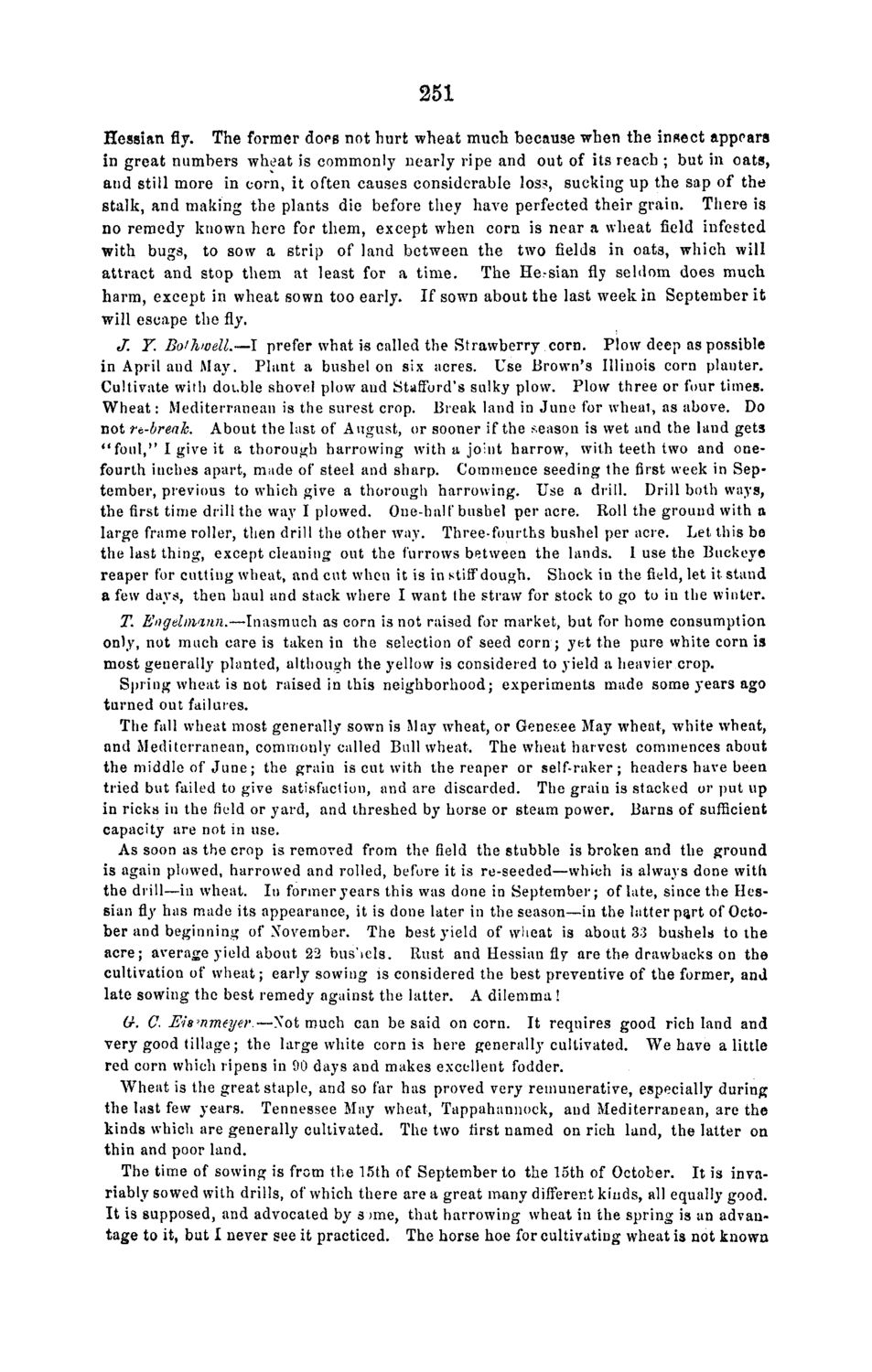| |
| |
Caption: Board of Trustees Minutes - 1868
This is a reduced-resolution page image for fast online browsing.

EXTRACTED TEXT FROM PAGE:
251 Hessian fly. The former does not h u r t wheat much because when the insect appears in g r e a t numbers wheat is commonly nearly ripe and out of its reach ; but in oats, and still more in corn, it often causes considerable loss, sucking up the sap of the stalk, and making the plants die before they have perfected their grain. There is no remedy known here for them, except when corn is n e a r a wheat field infested with bugs, to sow a strip of land between the two fields in oats, which will a t t r a c t and stop t h e m at least for a t i m e . The He.-sian fly seldom does much harm, except in wheat sown too early. If sown about t h e last week in September it will escape the fly. J. Y. Bofh>velL—l prefer what is called the Strawberry corn. Plow deep as possible in April and May. Plant a bushel on six acres. Use Brown's Illinois corn planter. Cultivate with double shovel plow and Stafford's sulky plow. Plow three or four times. W h e a t : Mediterranean is the surest crop. Break land in J u n e for wheat, as above. Do not re-break. About the last of August, or sooner if the season is wet and the land gets " f o u l , " I give it a thorough harrowing with a joint harrow, with teeth two and onefourth inches apart, made of steel and sharp. Commence seeding the first week in September, previous to which give a thorough harrowing. Use a drill. Drill both ways, the first time drill the way I plowed. One-half bushel per acre. Roll the ground with a large frame roller, then drill the other way. Three-fourths bushel per acre. Let this be the last thing, except cleaning out the furrows between the lands. I use the Buckeye reaper for cutting wheat, and cut when it is in stiff dough. Shock in the field, let it stand a few days, then haul and stack where I want the straw for stock to go to in the winter. T. Engelniaun.—Inasmuch as corn is not raised for market, but for home consumption only, not much care is taken in the selection of seed corn ; yet the pure white corn is most geuerally planted, although the yellow is considered to yield a heavier crop. Spring wheat is not raised in this neighborhood; experiments made some years ago turned out failures. The fall wheat most generally sown is May wheat, or Genesee May wrheat, white wheat, and Mediterranean, commonly called Bull wheat. The wheat harvest commences about the middle of J u n e ; the grain is cut with the reaper or self-raker; headers have been tried but failed to give satisfaction, and are discarded. The graiu is stacked or put up in ricks in the field or yard, and threshed by horse or steam power. Barns of sufficient capacity are not in use. As soon as the crop is removed from the field the stubble is broken and the ground is again plowed, harrowed and rolled, before it is re-seeded—which is always done with the drill—in wheat. In former years this was done in September; of late, since the Hessian fly has made its appearance, it is done later in the season—in the latter part of October and beginning of November. The best yield of wheat is about 33 bushels to the acre; average yield about 22 bus'iels. Rust and Hessian fly are the drawbacks on the cultivation of wheat; early sowing is considered the best preventive of the former, and late sowing the best remedy against the latter. A dilemma ! 6r. C. Ehmmeyer.—Not much can be said on corn. It requires good rich land and very good tillage; the large white corn is here generally cultivated. We have a little red corn which ripens in 90 days and makes excellent fodder. Wheat is the great staple, and so far has proved very remunerative, especially during the last few years. Tennessee May wheat, Tappahannock, and Mediterranean, are the kinds which are generally cultivated. The two first named on rich land, the latter on thin and poor land. The time of sowing is from the 15th of September to the 15th of October. It is invariably sowed with drills, of which there are a great many different kinds, all equally good. I t is supposed, and advocated by s )me, that harrowing wheat in the spring is an advantage to it, but I never see it practiced. The horse hoe for cultivating wheat is not known
| |